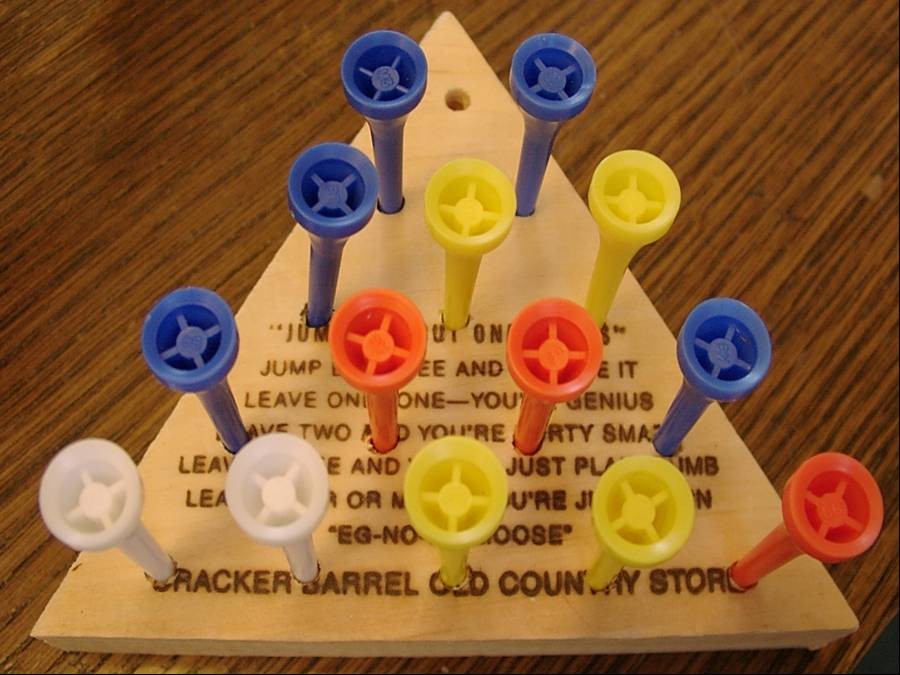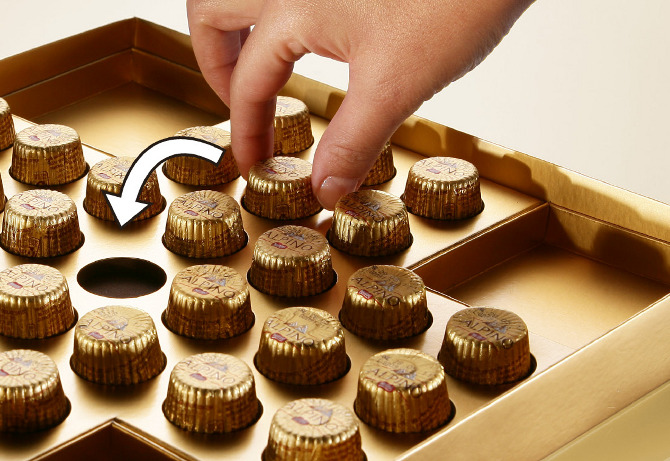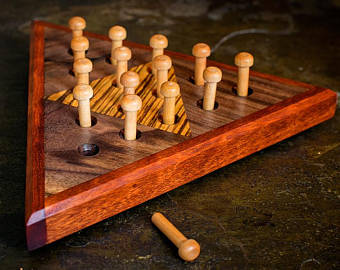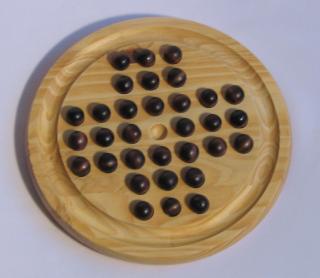Peg Solitaire
Peg Solitaire
Players: 1
Ages: 6 and up
Purchase: Triangle board or Plus sign board (affiliate links)
Math Ideas: Spatial Reasoning, Algorithms
Questions to Ask:
How many pegs do you usually end with?
At the end of the game, where are the leftover pegs?
When I was a kid, my parents bought me a triangular peg solitaire game from a Cracker Barrel, and I never could figure it out. No matter how hard I tried, I couldn't end the game with one peg. I always ended the game with two or three pegs, no matter how hard I tried.
Well, I am happy to announce that I dug this game out of the closet recently, inspired to finally conquer my old nemesis. And I did it! At long last, this deceptively challenging game of pegs and holes was within my grasp.
How to Play
There are two variations of peg solitaire that I have played, one on a triangular board and the other on a plus-sign board.
In each game, the rules are the same. You may remove pegs by jumping pver them with another peg, as in checkers. Your goal is to jump these pegs over each other, one by one, until only a single peg is remaining. That's it!
As with many of my favorite mathematical games, the rules are simple to explain, but the game itself is a challenge for kids and adults alike.
Where's the Math?
Peg solitaire is a great way for kids to interact with algorithms. Simply put, an algorithm is a set of steps that one can use to solve a problem. People who solve Rubik's Cubes in ten seconds use algorithms, but so to people who use long division to solve 524÷6. In either case, you are using a set of steps that can be generalized to solve all sorts of similar problems. Both versions of peg solitaire give kids a chance to develop, test, and improve algorithms for leaving one peg remaining.
At first, kids will play the game more or less at random, hopping pegs wherever they see the opportunity. That's certainly how I started as a kid. But as they play, your child may begin to notice patterns and change their decisions as a result.
For example, they might start to notice that at the end of the game, they usually have a few pegs stranded on the board, too far away to jump and remove each other. So if there is a way to keep the pegs closer to each other, perhaps they can improve their score. They create a goal and a rudimentary algorithm, such as "always jump towards the middle of the puzzle."
Over time, they might realize that this algorithm isn't quite sophisticated enough to win, and so they try to amend it to improve their score. I have no idea what different methods and algorithms your kids might develop; I only know the ones that I came up with as an adult.
Regardless of the specific algorithms your kids develop, the fact that they are developing algorithms is itself a mathematical experience. They are using the beginnings of the same mental models that computer programmers use to create chess programs that can beat the best players in the world, or Amazon recommendations that, frankly, could be a bit more sophisticated.
Questions to Ask
Peg solitaire is, of course, a solitaire game, so sometimes the best thing to do is leave your kid alone and let them explore.
That said, if I were to ask questions, I would try to guide my child to noticing the patterns in the results of their games. "How many pegs are left over in your game? Where do the leftover pegs end up?" is a great set of questions, because it gets kids thinking about the edges of the game as compared to the center.
If your child is getting frustrated, you could set up a minigame and ask her to try to solve it. Solving an entire 32-peg plus sign might be intimidating, but if you set up 9 pegs in the center, perhaps they can solve that! (or can they...)
If your child wants a challenge, here's a good one for either variation of the game: "What is the largest number of pegs you can fit on the board, so that no peg can jump over any other peg?"
Lastly, I am a sucker for any game that can be a fun mathematical canvas, even when you aren't playing the game (See: Blokus). Both boards, but especially the larger plus-sign board, give your kids a chance to explore all sorts of shapes and designs. They might even notice a pattern in their unstructured exploration that could help them with the game itself!
Buy Peg Solitaire: Triangular Board or the Plus Sign Board on Amazon (affiliate links)





